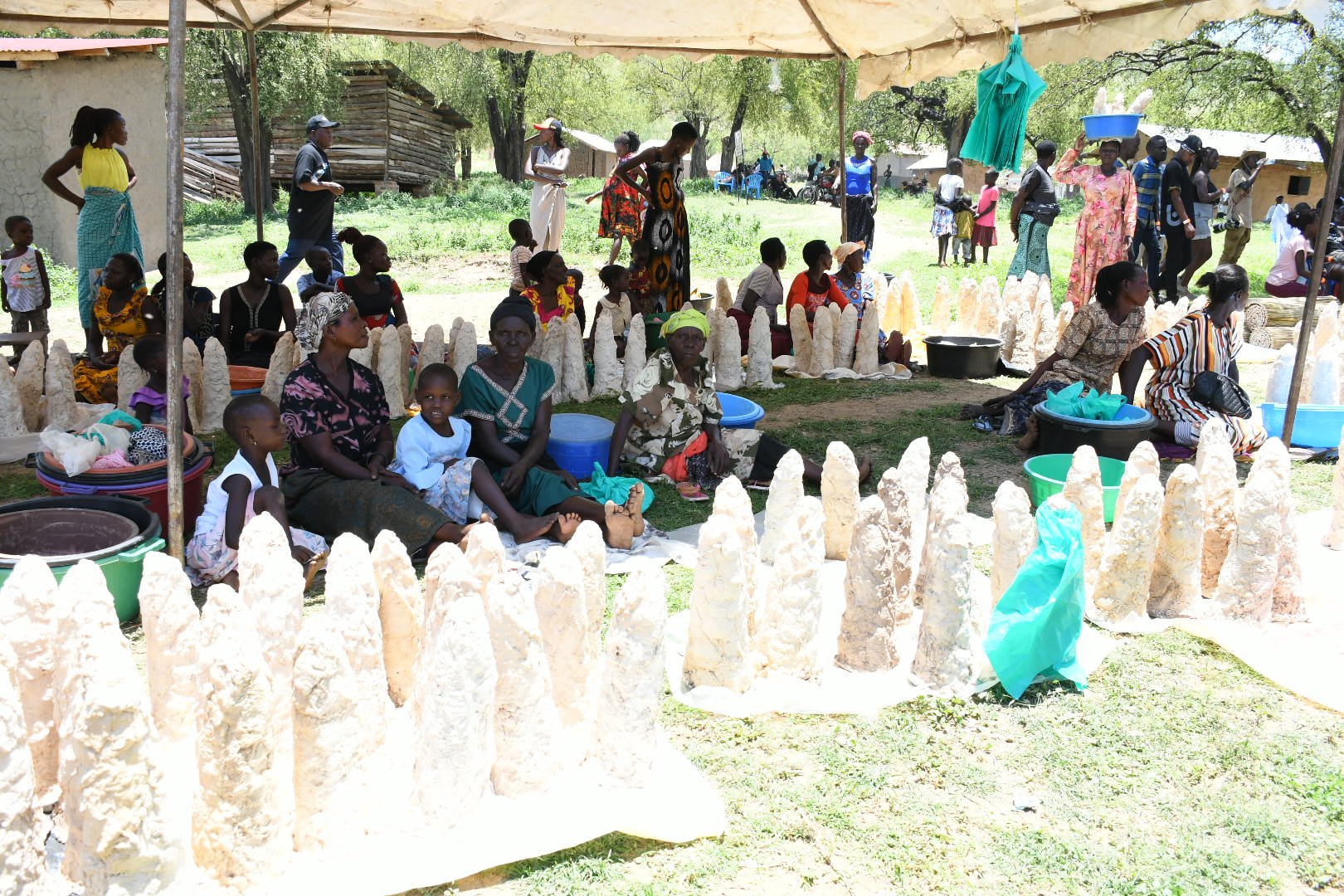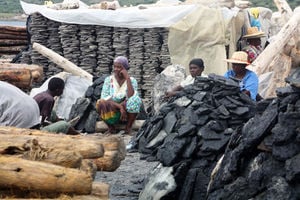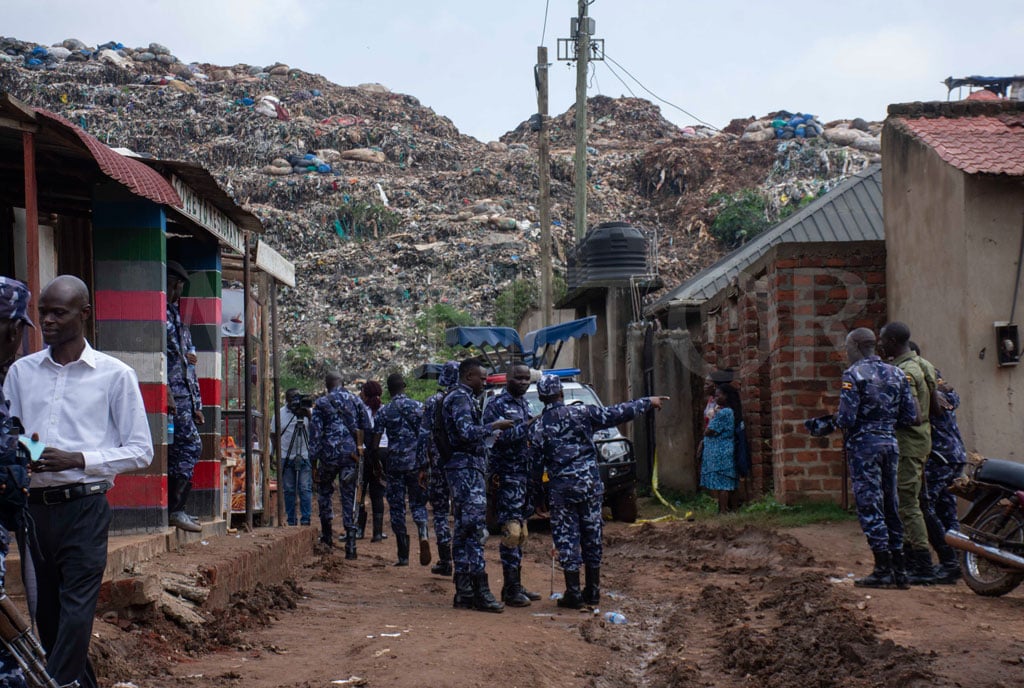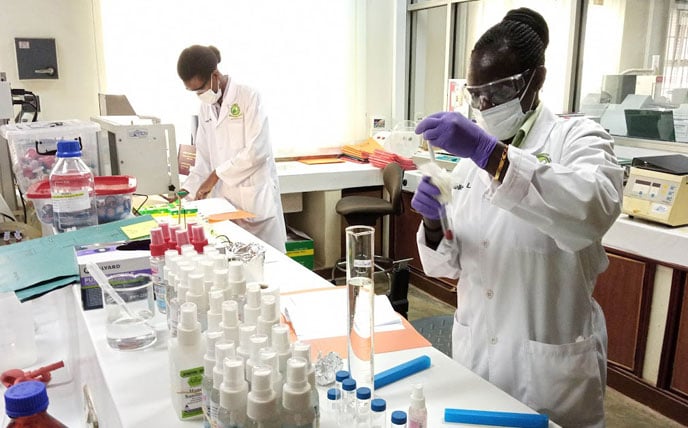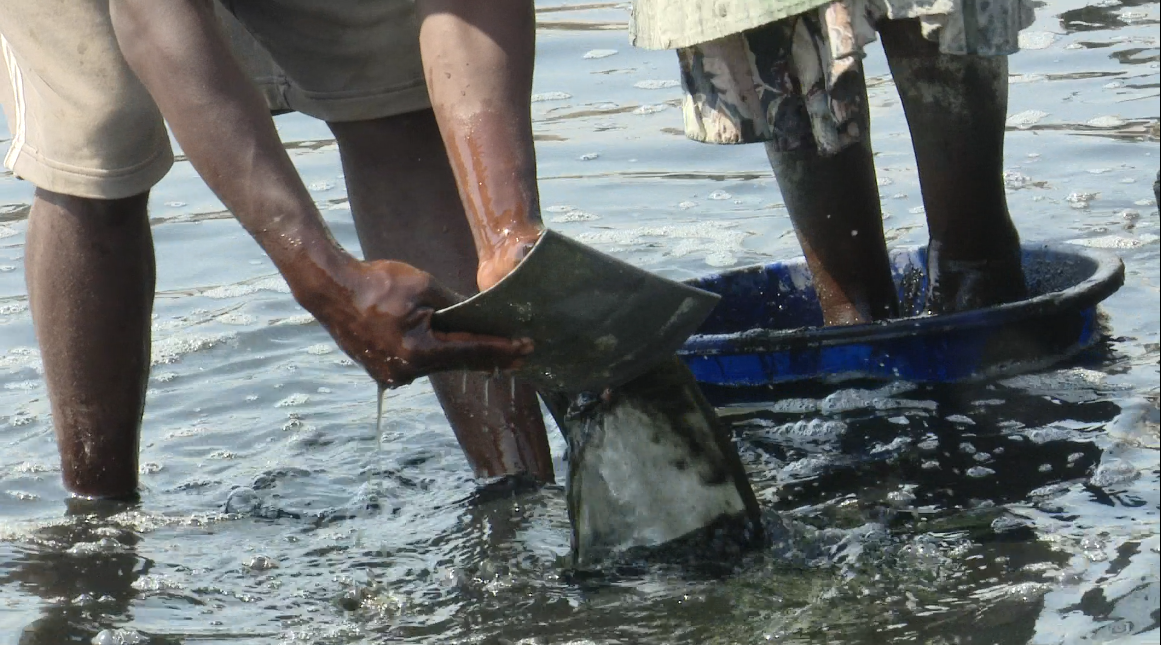
None of the salt miners wears protective gear before stepping into the pans. Naturally, prolonged exposure to hazardous chemicals in the saline water has a strong effect on their skin. PHOTO/ COLLINS MUHWEZI
According to a 2013 study, Slow Death at Katwe Salt Lake: Impacts of Extraction on Women in Africa, Lake Katwe produced approximately 15,000 tons of crystalline salt annually. The lake is surrounded by more than 10,000 salt pans from three grades of salt.
A 2013 study titled "Characterisation of Raw Materials for Salt Extraction from Lake Katwe, Uganda" found that Grade One salt, mainly used for domestic consumption, is high-quality salt obtained from clean salt pans, while Grade Two salt is extracted from the bottom of mud-lined salt pans and is used for animal consumption.
The salt pans host more than 300,000 salt miners. They are hereditary and if someone wants to acquire one, they have to part with between Shs7m and Shs10m, depending on its location and the amount of salt harvested in a day.
Halima Nassaka, a salt pan owner, says some pans are big enough for the miner to harvest 20 to 50 sacks of salt a day.
“In the rainy season, we miss out on pink salt, which is very marketable. So, we are praying to God to give us enough sunshine. This means that from September to December, we lose income. Seventy percent of the population in this area depends on salt mining, while the remaining 30 percent are fishermen,” she says.
Pink salt is believed to have notable health benefits because it contains several minerals such as magnesium, calcium and potassium. However, the supposed health benefits have not been supported by science.
Nassaka adds that the fish is too expensive that the local population cannot afford to eat it. It is exported to the Democratic Republic of Congo (DRC).
Health effects of salt mining
Henry Sande, a salt miner, explains that his workers use spades to scrap crystals off the ground and push them into the water in the salt pans. The crystals spend seven days under the water.
“We keep on checking on them to find out if they are building layers under the water. After seven to 14 days, the crystals are extracted from the water and the salt from the crystals is put out to dry. In the hot season, the drying process takes up to seven days,” he explains.

This entire process means that the salt miners spend the better part of the day standing and bending in the salt pans. None of the salt miners wears protective gear before stepping into the pans. Naturally, prolonged exposure to hazardous chemicals in the saline water has a strong effect on their skin.
Some of the common ailments complained about include dehydration, chemically-induced burns, and infections.
“Some people develop patches on their legs because there is no oxygen in the water we work in. There is a lot of pain when you try to pull the skin on the patch. We advise our workers to drink four litres of water a day to avoid developing those patches,” Nassaka says.
Dr Ezra Namanya, attached to Nyahuka Health Centre IV in Bundibugyo District, confirms that people frequently exposed to salty water during mining are at risk of developing various skin conditions, particularly on their legs.
“Prolonged exposure leads to dehydration of the skin, often affecting areas around the feet and hands, and results in persistent irritation. Salty water removes dead skin cells and can cause ‘swimmer’s itch,’ a condition where microscopic parasites, often released from infected snails, cause skin irritation,” he says.
To prevent this, Dr Namanya advises that immediate or frequent bathing after exposure to salt wells is necessary.
“Salt water can also trigger allergic reactions, causing redness, swelling, and respiratory allergies due to the inhalation of salty moisture, especially in the mornings. Prolonged exposure can lead to chronic inflammation, small cuts, hyperpigmentation, scarring, acne, and eczema on the skin,” he says.
She adds that due to the tough economic situation, some people, when the patches peel off their skins, go into the salt pans with open wounds.
“You find that people working here have many fresh ulcers on their legs. The salt just cuts through the skin. To protect the wounds from salt water, they cover them with a polythene bag and hold it in place with superglue, which corrodes the skin,” Nassaka explains.
Women make up more than 50 percent of the mining workforce around Lake Katwe. According to a 2021 unpublished study, Harvesting the truth about salt mining: An assessment of the factors and demographics that influence women to become salt miners, Katwe Uganda, the population of female miners at Lake Katwe is primarily composed of an ageing population of women.
It was found that 71.2 percent of the respondents are 40 years or older. The younger generation has been slow to join the mining industry and currently, women between 18 and 30 years only make up a small portion (12.1 percent) of the female miners at Lake Katwe.
Reproductive issues
However, besides skin irritations, there is a more silent problem that women salt miners have to deal with. Nassaka laments that working without protective gear leaves the women’s reproductive organs exposed.

Halima Nassaka
“There is a high rate of inflammation of the uterus among women who have worked for many years in these salt pans. I can identify 10 women, including my mother, who have had their uteruses removed. Women work in the salt pans from morning to evening, and the salt water keeps entering their reproductive system,” she says.
To extract salt, the miners mix hydrogen, sulphur, and ammonia into the salt pans. All these chemicals end up in the women’s reproductive system.
On average, women miners earn between Shs7,000 and Shs10,000 a day, which is too low to cover their daily family needs and healthcare needs.
To try to mitigate some of the effects on their health, the miners improvise protective gear. The men wear condoms or tie polythene bags around their genitalia before entering the salt pans.
On the other hand, the women who can afford to, wear sanitary pads the whole day. The less fortunate ones improvise old pieces of cloth as pads or smear cassava dough on their reproductive organs before they enter the pans.
Chronic back pain, due to spending hours bending in the salt pans was also reported as one of the major health hazards that affect both men and women.
What district authorities say
John Bosco Kananura, the chairperson of Katwe Kabatooro Town Council, where Lake Katwe is located, confirmed that salt miners lack protective gear and often complain of various illnesses.
“Recently, together with other local leaders, I collaborated on a research project affiliated with Makerere University, focusing on the health and safety of salt miners. I hope this research will lead to the provision of protective equipment for miners. Some of them have been diagnosed with health issues, and we suspect these might be connected to exposure to certain minerals used to extract salt,” he says.
Kananura’s concerns are shared by Eliphaz Muhindi, the LCV chairperson of Kasese District, who advised the government to explore advanced mining methods to improve safety conditions for miners.
“I have heard of the health hazards that the salt weaners suffer because they are using rudimentary methods to protect themselves from the effects of long exposure to salt. For instance, some of them are using tyres to prevent salt water from reaching above their knees,” he says, adding that such methods are insufficient.
In 2022, Uganda exported $7.4 million worth of salt to other countries. However, the country still imports about 90 percent of the salt it consumes from Kenya. In 2019, Uganda imported Shs94.7 billion worth of salt.
Implications on environment
Nicholas Kagongo, an environmentalist from Katwe Eco-Tourism Information Centre, has issued a warning that Lake Katwe could disappear in 30 years if degradation activities around it are not curbed. Kagongo adds that the lake is facing the threat of extinction due to increased human activities on its steep slopes, where people have set up cotton and maize gardens.
“These activities are gradually weakening the lake’s shorelines. Katwe Salt Lake and its salt pans are indeed renewable resources, but the current rate of degradation is alarming. The vegetation cover is gone due to continuous cultivation. We urgently need government intervention to stop these activities,” he says.

Workers load salt bags on trucks
The most heavily encroached slopes include Kisinga village on the lake’s eastern side, where farmers have established gardens, as well as Kanyamiyoba village.
Kagongo adds that the environmental impact of cultivation on the lake’s slopes is significant, with rainfall-runoff flowing directly into the lake and causing it to flood and preventing salt production.
“An increasing number of people are extracting salt from the lake, surpassing its sustainable capacity. We need regulation to a manageable level,” he advises.
The town council has also set up a conservation committee which periodically visits the salt pans and offers advice on the health and environmental impacts of salt mining.
As such, miners have been restricted from entering the lake every day. Instead, they access it every Tuesday and Thursday to extract Grade Three rock salt. This is extracted manually by men from the centre of the lake, beneath its surface.
ABOUT LAKE KATWE
Lake Katwe is known throughout Uganda and the East African region for its substantial salt production and has been producing high quality salt for many years. Geographically, Lake Katwe is found within an explosion crater in the formerly active volcanic area north-east of Lake Edward and south-east of Lake George.
The lake is found in the small run-down town of Katwe on the outskirts of the Queen Elizabeth National Park in the Kasese district and covers an area of approximately eight square miles. Its shores are lined with small ponds or pans of water from which salt is extracted from the bottom in a process called salt panning. Salt content of the lake waters is approximately 13.5 percent. The lake bed is 0.8 meters thick and contains approximately over 12 million tonnes of salt.
Produced by Nation Media Group in partnership with The Bill and Melinda Gates Foundation.


